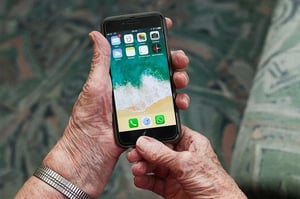Staying active is one of the best things you can do for your health, especially as the years go...
10 Healthy Habits to Overcome Digital Fatigue
Most of us spend more time staring at screens than we’d like to admit. Phones, computers, tablets, and TVs fill nearly every hour of the day—and even when we’re “off,” notifications keep pulling us back in. Over time, that constant connection can take a real toll, leaving us mentally foggy, physically tense, and just plain worn out. That’s digital fatigue.
If you’ve caught yourself rubbing tired eyes, losing focus, or feeling drained after another day online, it’s a sign your mind and body need a break. Here’s how to spot the warning signs and simple ways to start feeling better.
Digital Fatigue Indicators
 Signs of digital fatigue include:
Signs of digital fatigue include:
- Burning, itching, or sore eyes
- Sore neck, shoulders, and back
- Light sensitivity
- Headaches
- Trouble concentrating
- Mental health issues like depression, anxiety, and other mood disorders
Luckily, digital fatigue can be managed. Here are nine steps you can take to avoid digital fatigue.
Take Screen Breaks
Between work, home, and socializing, we spend a lot of time engaging with screens. It’s not uncommon for some of us to spend almost our entire day in front of one. This is a classic recipe for digital fatigue, so here are some ideas to disrupt the cycle.
- Take a walk without your phone.
- Have your morning tea or coffee without the warm glow of social media.
- Set fifteen-minute screen breaks into your calendar two or three times a day and follow them religiously.
- Use an app that helps remind (or even forces) you to take a break.
Take a Nap
Closing your eyes and resting is an excellent way to take time out from your digital devices. Also, it's a good way to regain energy during the day. The Sleep Foundation recommends a nap of only 20-30 minutes to avoid entering the deep sleep cycle. That way, you’re more likely to wake up refreshed. If you’re limited by time or place for a nap, your car might be an ideal place to catch a quick snooze over the lunch hour.
Click here to learn more about the pros (and cons) of taking a nap!
Blue-Light Filters
Digital gadgets like our beloved mobile phones, tablets, and laptops emit blue light, also known as high-energy visible (HEV) light. When engineers developed electronic screens, they relied on plenty of blue light wavelengths to make images easier to see. While this light creates sharper images, it also poses a risk to human eyes, since we often stare at screens for hours at a time. As a result, we experience problems like eye strain, dry eye, and other ocular problems, all of which contribute to digital fatigue. Blue-light filters can help reduce these issues.
Return to Off-Screen Alternatives
 While reading a book on your phone or scrolling through the news on an app is convenient, relying exclusively on this type of media contributes to digital fatigue. Try switching to paper-printed formats occasionally to give your brain a break.
While reading a book on your phone or scrolling through the news on an app is convenient, relying exclusively on this type of media contributes to digital fatigue. Try switching to paper-printed formats occasionally to give your brain a break.
Manage Your Attention
Mobile applications are masterful thieves of attention. Most of us have probably experienced some version of “app trance,” where we find ourselves mindlessly flipping through screen content while we are supposed to be listening to a meeting or presentation on a Zoom call. This kind of multitasking is counterproductive. It makes it harder to focus well enough on any one task to do a good job of it, meaning we do subpar work when we're distracted. It’s also disrespectful to others who are trying to communicate with us. Finally, it only adds to our overall digital fatigue, so try not to get sidetracked with shiny digital things and focus on what is important.
Find a Way to Connect to Tangible Things
Increasingly, we live in a blend of real physical and digital spaces. This is a new experience for human beings. It is helpful to get out and connect to something that doesn't require an electronic device. Activities like bird watching, walking, hiking, meditation, fishing, yoga, or even an exercise session at the gym can help break the digital tedium.
Cultivate Face-to-Face Interactions
In the same spirit as connecting with physical things, placing more emphasis on face-to-face exchanges with others also combats digital fatigue. Although interacting with people via screens can increase productivity by some measurements, it also has limitations in terms of the depth of communication that is achieved. Businesses are increasingly issuing return-to-office mandates because they understand the value of employees physically working together. In our personal lives, making time to get together with others instead of interacting via screens not only improves our relationships but also boosts our own mental health.
Set Boundaries
In an ever-connected world, we often receive work-related emails, texts, chats, and other notifications after hours. It is okay to establish a firm boundary when your office hours end and stick to it. It is also okay to turn on do-not-disturb mode at night when you want to unwind before bed. Boundaries are often blurred or ignored today, making it all the more reason to stick to them.
Exercise
Human beings are meant to move about, not to sit hunched over a keyboard for eight hours a day. Moving your body, stretching your muscles, and getting an appropriate amount of exercise benefits every one of your body systems. It also benefits your mental health, and best of all, it can be done without a screen!
We can’t unplug from technology completely, but we can decide how it fits into our lives. Taking breaks, setting boundaries, and spending more time in the real world help clear the fog that screens create. When you give yourself space from the digital noise, you’ll find more energy, focus, and calm waiting on the other side.







